Journal of
eISSN: 2373-6410


Review Article Volume 12 Issue 3
Physician of functional diagnostics of SBIH, Regional psychoneurological clinic, Russia
Correspondence: Rosman SV, Physician of functional diagnostics of SBIH, Regional psychoneurological clinic, Tver, Russian Federation, Russia
Received: June 14, 2022 | Published: June 30, 2022
Citation: Rosman SV. Neurophysiological foundations of the human mind. J Neurol Stroke. 2022;12(3):72-77. DOI: 10.15406/jnsk.2022.12.00504
In the context of the search for a new paradigm of the functioning of the human Mind, a new method of investigating the functional ability of the brain is proposed - the dispersion of the amplitude–frequency characteristics of the alpha rhythm of the EEG (DAFCAR). It is assumed that it is a marker of the processes occurring in the brain during information processing, considering them from completely new positions.
Keywords: search for a new paradigm of the human Mind, electroencephalography, DAHAR, diagnosis of mental illness
DAFCAR, dispersion of the amplitude-frequency characteristics of the alpha rhythm; NGNB, neural-glial network of the brain; EEG, electroencephalography
A large number of events in our life and the political life of states force us to return again and again to the problems of the human Mind, because the behavior of people in various life situations allows us to express doubts about their reasonableness. If these were individuals, there would be no problems, but we are talking about the population of entire states. Why do people ignore the absolutely obvious facts and rush into the abyss of disastrous state ideologies that have long proved their ruinousness? Why can large human masses be carried away by crazy ideas, and after a while the participants themselves only shrug their shoulders in bewilderment when they are reminded of certain aspects of their behavior?
It seems to me that the problem of all these social difficulties lies in the fact that idle politicians, sociologists and philosophers who deliberately bypass the biological aspect of human activity, because you need to have special knowledge in biology and neurophysiology, and this is more difficult than inventing abstract social theories that rarely come true. But the thirst for parasitism on human intelligence and the inevitable desire of people for everything unusual and intelligent conversations always wins.
Another aspect of this problem is the conviction of many people that man has a divine essence, and it is impossible to get into it with the dirty paws of materialism. This religious fundamentalism is based on a simplified idea of God as a being who monitors all our manifestations, every grain of sand in the universe. How he does it does not matter, but the main thing is to ask him about something in time, and even with gifts of gratitude.
All together, we can assume that the main reason for all the misconceptions in the field of neurophysiology and the sciences of the human Mind lies in an outdated paradigm that believes that it is incomprehensible, abstract and not subject to scientific study. This is especially evident in psychiatry and other psychological sciences, which in practice are not sciences because they do not have any objective research method.1
It is naive to assume that all the problems of the Mind can be solved in a small work, but some successes achieved in the search for a correlation between psychopathology and dispersion disorders in the EEG spectrum.2–4 allow us to come up with some particular ideas about the essence of the human Mind. That's how, step by step, we will come to the Truth.
How did the human Mind arise and why is it needed?
Nature lives in a state of constant increase of entropy – the inevitable destruction of the material component of the Universe due to the expenditure of primary energy received by it in the process of the Big Bang. At a certain stage of Evolution, an alternative path of movement against the entropy vector appeared in nature, as in a stream of water we can observe the movement of objects against the current if they encounter an obstacle. Using energy from the outside, by recycling it in a certain limited system, we can delay the increase of entropy in the system indefinitely as long as there is a source of "pumping" energy from the outside. This principle was formulated by James Clerk Maxwell in 1872 and called "Maxwell's Demon" (Figure 1).
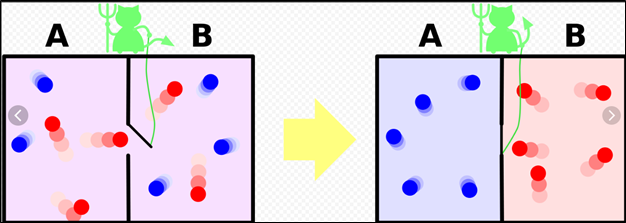
Figure 1 "Maxwell's Demon" - preservation of the existence of the system against the entropy gradient by organizing a special mechanism for separating energetically active (red circles) and inactive particles (blue circles), i.e. an artificial state of increased energy in sector B.
In Nature, this principle is implemented in the form of Life, in which the metabolism acts as a "Maxwell Demon", extracting the energy necessary for the functioning of the system from the external environment. Thus, within a certain species, entropy ceases to act, although individual individuals of this species are subject to entropy, which pass the evolutionary baton through the reproduction process, ensuring the stability of the species.
For the uninterrupted supply of energy and plastic material to the system, it needs well-developed information support, and this is a fundamental requirement. The evolution of species is the evolution of the improvement of the information system of organisms. Starting from photo-, thermo-, baro-, and chemosensitive cells of the simplest animals and plants, through the diffuse ganglion nervous system of invertebrates - to the central nervous system of animals (Figure 2).
The central nervous system of man stands at the very pinnacle of evolution and allows the most complete, of all living beings, to provide access to the elements vital for the existence of the species - food, shelter, information.
However, is the human brain so perfect? Why does such a question arise more and more often?
There are many myths about human thinking, since antiquity. Abstract ideas of philosophers have endowed the human Mind with many properties that it does not possess. And we need to start with the neurophysiological parameters of the human brain, especially since now we have something to compare it with – artificial intelligence (AI).
And the possibilities of the brain in the field of information processing are very modest. Contrary to popular belief, there is no electricity in the brain – excitation moves along the nerve fibers – a depolarization site, the polarity of which is opposite to the surrounding areas. The lability of the nerve fiber (maximum resolution of impulses) is 1000 imp/s, muscles – 200imp/s. The lability of excitable biosystems is practically due to the duration of the phase of absolute refractoriness. Thus, the phase of absolute refractoriness of a nerve fiber is on average 1ms, that is, in 1 second with rhythmic stimulation with a frequency of 1000 Hz, the nerve can reproduce 1000 pulses. The speed of movement of a nerve impulse along a slow fiber is limited to about two meters per second, whereas along a fast fiber the signal accelerates to 120 meters per second.
It is not even worth comparing with AI, whose processor clock frequency is in the tens of GHz (that is, several tens of billions of pulses/sec and the speed of electrons moving through the connections is close to the speed of light.
But the main catastrophe in understanding the mechanisms of Mind action lies in very small brain volumes, because within the framework of the existing paradigm, perceiving a certain image, the brain extracts existing standards from memory, compares them with the received images and, depending on this, makes a decision on this or that action. Where are these standards stored? It is impossible to imagine a memory storage of such a volume that every person needs to have in order to carry out their functions. Here dreamers come to the rescue, who attract quantum strings, multidimensional spaces and a connection with a Higher Mind that performs the function of Google's "Cloud". But even that's not all. When we say "A person thinks", we imagine two interrelated processes: information analysis and solution synthesis. But how can a person analyze information with such insignificant neurophysiological capabilities? AI has logic blocks with monstrous speed – it's clear there, but where are they placed in the human brain?
Researchers invariably came to a paradoxical conclusion: a person does not have any memory in the form of a repository of information, he is not able to analyze information, much less synthesize it from the results of thinking about decisions. Coming to this conclusion, science has always given up and waited for new evidence of the unprecedented capabilities of the brain in the field of information processing.
And what if the fact is that we basically have a wrong idea of how the brain works? After all, there was the "first call" - the idea of IM Sechenov5 subsequently confirmed by the works of Nobel Laureate I.P. Pavlov6 that brain activity is reflex, i.e. there is no analysis of information – there is a reflex, a direct response of the body to a certain impulse in the form of an action. The lack of data from neurophysiology and cybernetics brought all these ideas together in the early 20th century to the reflex arc, in which it is completely unclear how, in response to different forms of excitation of the same analyzer, the excitation of different parts of the cerebral cortex occurs.
The next stage in the creation of a new paradigm of neurophysiology was the work of P.K.Anokhin, in which the fundamental ideas were the theory of afferent synthesis – a kind of creation of "machine coding" of afferent information in the neural network of brane and neural associations - a kind of result of this "machine coding" with the creation of a semantic image of afferent information in the form of a certain configuration of excited neurons, which-something like a modern QR code, where the black areas show these excited neurons.7 In any case, P.K. Anokhin's theory showed a possible mechanism of selection of neuronal excitation in response to a variety of afferent information, but did not answer the main question: "How does it all work?".
Many of the above questions are answered by studies in the framework of non-epileptic computer electroencephalography and dispersion analysis of the amplitude-frequency characteristics of the alpha rhythm (DACHHAR).8,9
By universal recognition, it is the alpha rhythm that is the most diagnostically significant rhythm in the EEG, since only it shows some very significant patterns associated with brain activity.8,9
The origin of the alpha rhythm for neurophysiology still remains a mystery, since it is considered from the classical positions of management mechanisms that cannot explain the creation of neural associations and the "switching" of excitation from one center to another depending on the content of the information flow.8
Considering all this, taking the alpha rhythm of the EEG as a marker of the mechanism of processing afferent information by the brain, it is possible to create a new model of information processing and the functioning of the Mind itself.
In the matrix of the brain, in an environment continuously updated with the help of a glymphatic system associated with the cerebrospinal fluid system10 an oscillatory electrophysiological environment is created with the help of auto-oscillatory reactions of Belousov-Jabotinsky11 which leads to the ordering of the ionic composition of the matrix, similar to the mechanism of E. Khladni, which was shown in 18 c. that chaotically arranged particles can create ordered structures in an oscillating medium (Figure 3).

Figure 3 "Khladni figures" - creation of ordered structures from sand lying on an oscillating elastic plate.
It may be objected that this concerns the elastic properties of grains of sand, but we know that the general laws of the oscillatory process extend even to electromagnetic and sound waves.Within this ordered (synchronized) system, two networks function – neural and glial. For a long time, the glial network was not considered at all as an active system involved in information exchange - the glia played a supporting and trophic role in providing neurons with nutrients. It seems that the role of the glial network is no less than that of the neural network.
The glial and neural networks of the brain carry out the same afferent synthesis that P.K. Anokhin predicted.
This happens as follows: the excitation along the afferent fibers enters the glial network and begins to spread through the interneuronal and interglial connections, which is an innumerable number of loops in which the excitation circulates according to the “re-entry” type. This is called an iterative-recursive system. The iterative-recursive system begins to arrange functioning elements - in this case, glial cells located around neurons – into a fractal "pattern", which was first described by B. Mandelbrot12 for mathematical structures. A fractal is a complex mosaic structure in which its elements are self-similar to the structure as a whole (Figure 4A-4C). The main feature of the fractal, with its infinite variety, is that it strictly repeats the properties of the signal that generated it, passing through an iterative-recursive structure: changing the defining parameters of the information signal leads to a change in the fractal pattern. Thus, an unevenness of electrophysiological conditions around neurons is created, which has a complex fractal-mosaic character.13 This is exactly how neural associations are created according to P.K.Anokhin, which are a semantic representation in the brain of the information reality of the environment - its own-shaped analogue of QR coding of information (Figure 4D)
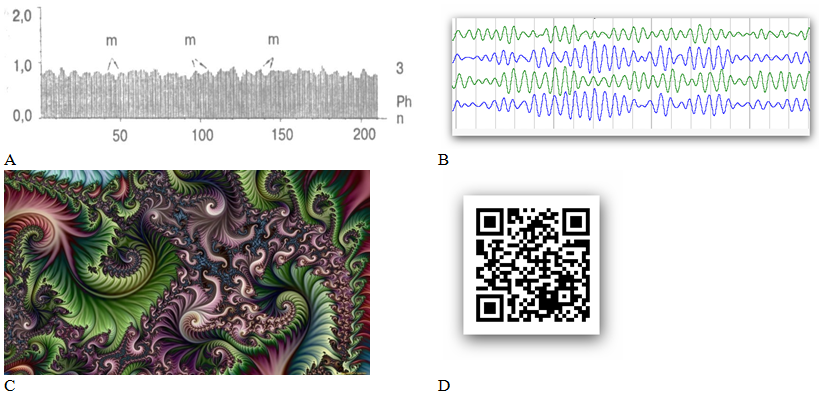
Figure 4 An example of phenomena in which regular and amplitude modulated elements are traced. (A)– Intervalocardiography (R.M. Bayevsky's technique), (B) alpha rhythm electroencephalogram, (C) Mandelbrot fractal, (D) QR coding.
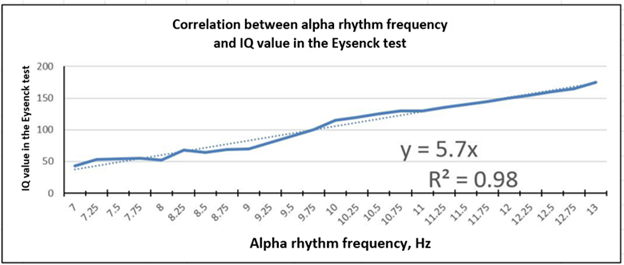
Figure 5 Dependence of IQ in the Eysenck test on the frequency of the alpha rhythm in the occipital leads of the EEG (O1;O2), Rosman S.V., 2020.
A very important element of the proper operation of this system is the stability of the alpha rhythm. Its spectrum obeys the Gauss law of normal distribution, and its deviation in frequency at rest is on average no more than 0.25 Hz (Figure 4B). Its frequency increases with brain activation and decreases with harmful effects on the brain. It was even possible to establish a relationship between the IQ in the Eysenck test and the frequency of the alpha rhythm (Figure 5).
Thus, the frequency of the alpha rhythm reflects the cognitive ability of the brain, its ability to distinguish the details of afferent information: the higher this ability, the smarter a person is. This indicator is determined by the frequency of the alpha rhythm in the occipital region - it is there that the cortical centers for evaluating visual information are located.
However, why, having reliable information, a person, most often, makes incorrect conclusions and commits ridiculous acts? The whole problem is in determining the priority of information and its interpretation, which are engaged in the frontal lobes of the brain.14 It is here, apparently, that the mechanism of human free will is located, which develops from the moment of man's expulsion from paradise and because of which a person must "earn his bread by the sweat of his brow," but also be called the pinnacle of Evolution in the development of Life.
We have already said that the brain, due to its peculiarities, is not able to analyze its activities, which would inevitably lead to the fact that a person would turn into a bio robot acting strictly in accordance with instinct. However, it turned out that there is at least one part of the brain that differs in parameters from the occipital lobes – these are the frontal lobes. Normally, the frequency of the alpha rhythm in them is 0.1-0.25 Hz different from the frequency of the alpha rhythm in the back of the head. This phenomenon is called delayed or accelerated dysfrontality. Most often there is a slowdown, and this is called hypofrontality.3,14 This is a very important moment in the evaluation of information – because, as we have already agreed, the brain cannot create logical blocks. The frontal lobes carry out corrective work with incoming information, based on the feedback mechanism, they set the rank priority of information by "correcting" the semantic image created by afferent synthesis during primary information processing in the visual hillock of the brain, which is a common center for collecting information from all sensory organs. And, again, there is no need for any storage of this knowledge and setting the necessary ranks – incoming information "automatically" includes a corrective rank for this information from the frontal lobes, reconstructing the resulting fractal picture and triggering a certain neural association. Thus, the frontal lobes are trained all their lives to develop the optimal ranking of this or that information. This process is called the development of social acceptability of human behavior.2,15
And this is the most important moment and feature of brain activity: its assessment of existing information is contextual. Since the 1950s, it has been known from S. Asch's experiments that a person perceives even completely obvious information contextually. If the surrounding society says "White" to black, then with a very high degree of probability every member of this society will repeat: "White" - this is the root of the phenomenon of propaganda. Social acceptability, if allowed to take its course, in favor of certain social groups and individual politicians, can work wonders. This is the secret of the popularity of individual works of art or artists, the fashion for a certain type of clothing and hairstyles. You can even force everyone to walk naked, if the framework of social acceptability allows it. And all this is the result of the activity of a healthy brain, in which the activity of the frontal lobes is "formatted" in a certain direction. It is worse when extremist elements interfere in this process. In the 30s in Germany, this led to the emergence of fascism. Everyone knows the 17 signs of fascism in however, few people know that the true basis of fascism is the biological ability of a person under the influence of extreme factors to roughly change the framework of social acceptability, passing into a borderline state between human society and a herd of animals in which freedom of will is standardized and unified. In such a society, it is permissible to kill, rob, rape – that is, to completely get rid of ideas about universal values. After the changes in social conditions, people will be surprised, no less than all the surrounding peoples, at the fruits of their actions and even accuse others of slander - they say they could not do such a thing. And that's all for mentally normal people.
The variance analysis of the amplitude-frequency characteristics of the alpha rhythm (DAHAR) makes it possible to understand how far psychological polysemantism can go in sick people when the functional ability of the neural-hyal network of the brain (NGSGM) is impaired.14,16 With his help, it was possible to completely rehabilitate Griesinger's theory of "unified psychosis", which he put forward in the 19th century, arguing that all psychopathology has a single root. In numerous studies, we have been able to establish that the single cause of mental illness is the entropy of the neural-glial network of certain parts of the brain, accelerated due to exogenous or endogenous factors.17
The new technique allows us to subdivide all neurophysiological disorders in psychopathology into 4 main groups:
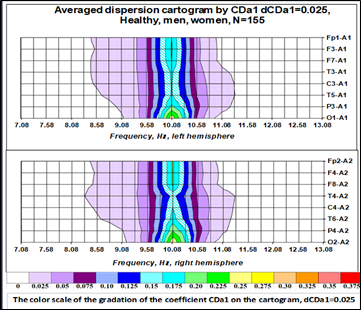
Figure 6 Dispersion cartogram in healthy patients. The frequency of the alpha rhythm in the frontal and occipital leads is 10 Hz, the frequency shift between the frontal and occipital leads is close to 0, the distribution of the alpha rhythm spectrum is normal (CDa1=0.27, CDa2=0.77)
Personality disorders and borderline personality disorders are characterized by a gradual slowing of the alpha rhythm, an increase in the difference in the frequency of the alpha rhythm between the frontal and temporal regions and an increase in the departure of the alpha rhythm spectrum from the normal Gaussian distribution (Figure 7).
A demonstrative example of psychopathology is dementia and mental retardation, which are characterized by a slowdown in the alpha rhythm in all departments (Figure 8). In this case, afferent information is not fully perceived by a person, without the necessary detail or in a distorted form.
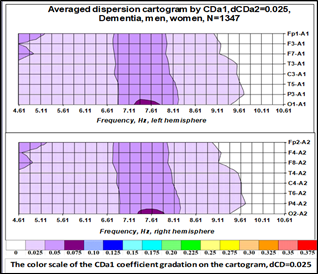
Figure 8 Dispersion cartograms for dementia. The frequency of the alpha rhythm is 7.61 Hz (norm - 10 Hz), the frequency difference in the frontal and occipital regions is no more than 0.25 Hz (norm), the gross deviation of the spectrum distribution from normal is Kda2 = 0.36 (norm =0.7).
It is even more interesting if, as a result of increasing entropy, disorders occur in the frontal lobes – hypofrontality. In mild cases, such disorders are accompanied by deviant behavior, especially in children and adolescents.18,19 In childhood, such delays in neuro-physiological development can be accompanied by ADHD and enuresis; in adolescence – the whole "bouquet" of teenage disorders – defiant behavior, hooliganism, shocking, blasphemous behavior. This was probably the reason for the use of weapons in schools – in far-reaching cases. On the other hand, with high cognitive parameters, the same hypofrontality can be a source of great talent and genius, since hypofrontality in borderline values is a source of dissent, a creative approach as a result of the actualization of latent signs, which is the main reason for heightened intuition and a non-standard approach to solving problems.
Usually such violations are borderline, and most often gradually turn into psychopathology. The extreme case of such a transition is schizophrenia (Figure 9).
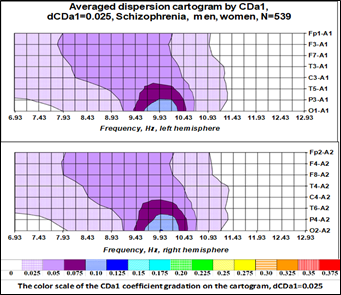
Figure 9 Dispersion cartogram in paranoid schizophrenia. The frequency in the occipital leads is within the normal range, the frequency difference between the frontal and occipital leads is more than 1 Hz, the deviation of the alpha rhythm spectrum from the normal distribution, especially in the frontal lobes.
A special article should be devoted to the mechanism of reflex action of the brain.
What preliminary conclusions can we come to based on the data of the objective method - DAFCAR?
None.
The authors declare no conflicts of interest.

©2022 Rosman. This is an open access article distributed under the terms of the, which permits unrestricted use, distribution, and build upon your work non-commercially.